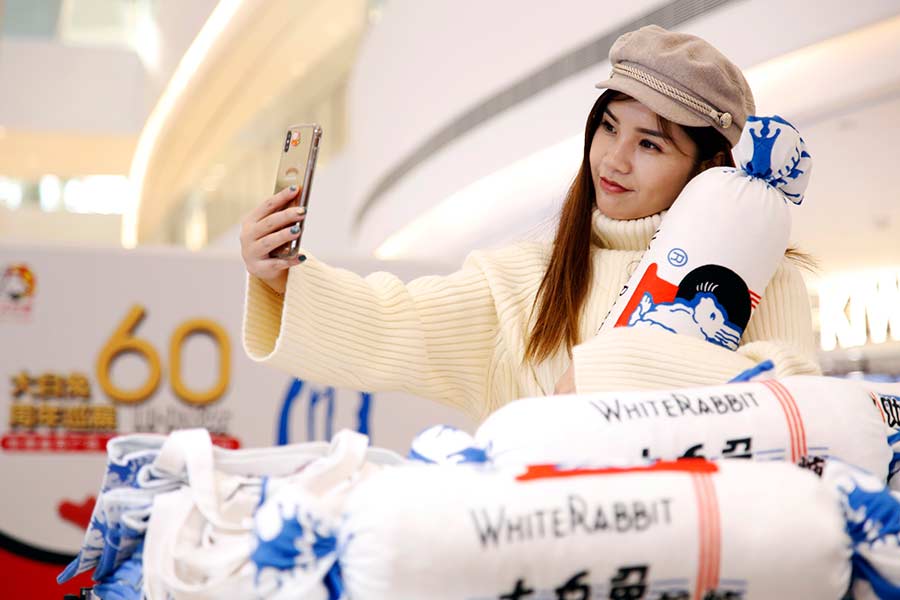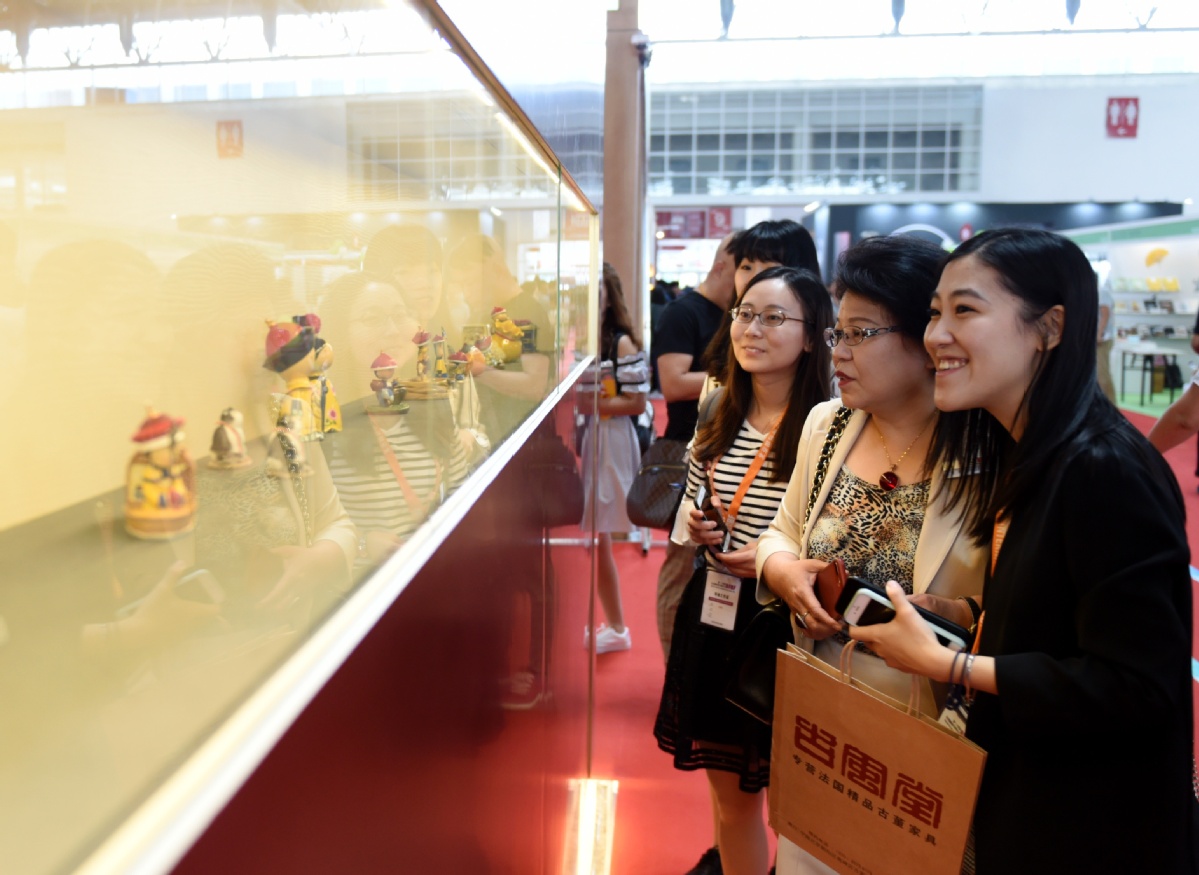
A woman takes a selfie with a White Rabbit souvenir. The household candy brand held an exhibition to mark its 60th anniversary in Shanghai earlier this year. (Photo: China News Service)
Chinese tourist destinations are swearing by global standards to earn more revenue
Having traveled to more than 20 countries and regions, Shi Hui, 36, a university lecturer in Shanghai, treasures the souvenirs he bought at each of the places.
Shi goes on at least one trip of about 20 days each year. The souvenirs help keep memories of his experiences overseas fresh, and he proudly flaunts them to visitors to his home.
He also travels widely within the Chinese mainland, but does not feel compelled to buy Chinese souvenirs. This is because most of them are made in Yiwu in Zhejiang province, and appear somewhat similar to each other, lacking distinctive features in terms of style, design and materials used. Worse, not all of them are authentic but shoddy, of low-end variety, he said.
Agreed Zhang Lanmei, 57, a retired Shanghai local. "I go on trips twice a year. I usually do not buy souvenirs on the road, because they are quite similar and less creative, which I can easily find at the stalls of Shanghai's Town God Temple."
Netizens in China joke online Yiwu's residents need not buy souvenirs at other places as all such articles originate in their hometown.
As Shi sees it, there is immense scope to reinvent the concept of souvenirs in general and Chinese souvenirs in particular.
Souvenirs, he said, should be made in various formats-a local snack, curries from India, black tea from Sri Lanka, dried apricots from Xinjiang Uygur autonomous region, or Spanish Iberian ham.
They could also be in the form of a delicate little gift of a key chain, handicraft or fridge magnet, but a special local product would be ideal.
Among his precious collection are Tibetan incense and hada from Tibet autonomous region, shawls from Kashmir, hangs of cloisonnéenamel from Beijing, Yengisar dagger from Xinjiang Uygur autonomous region, and a CD of exotic music.
"My favorite souvenirs are unique and distinctive objects. Stereotyped souvenirs at different destinations will fail to attract visitors and even dampen the impression of a special attraction," said Shi.
Zhou Weihong, deputy general manager of Spring Tour, a part of the Shanghai-based Spring Group, said the cultural and geographical values of local souvenirs are neglected in many cases, adding that the experience of overseas travel-related products can be a benchmark for Chinese souvenirs.
"In Japan, tourism souvenirs have a strong geographic characteristic, and they are made at a particular place, and can be bought only there, nowhere else. In Europe, souvenirs have strong cultural elements, and even a refrigerator sticker can be delicately made and worthy of being added to your personal collection," said Zhou.
The success of creative products released by the Palace Museum in Beijing and Shanghai Disney Resort has set a good standard for local souvenirs, experts said.

Visitors admire cultural and creative products of the Palace Museum that were put on display at the 24th Beijing International Book Fair in 2017. (Photo: Xinhua)
Since 2015, users of the Palace Museum's official app have received photos and information of one collection every day, bringing the collections and their fans closer.
As many as 480 styles of phone cases are created by the design team of the Forbidden City. "We designed headphones with beads, and our followers said this design let them feel like the emperor when making calls," Shan Jixiang, former curator of the Palace Museum who retired earlier in April, was quoted as saying by the Xinhua News Agency.
By the end of 2017, the Palace Museum released more than 10,000 products. It generated 1.5 billion yuan ($223.8 million) in revenue from its creative products in 2017 alone.
In the past couple of years, Dong Biyong, a millennial enjoyed buying many Palace Museum souvenirs, gifts and other creative products. "I tried quite a few from makeup kits, lipstick, blush, to various creative gadgets. They are good souvenirs in combining the Palace Museum culture and history with their functions," Dong said.
According to He Jianmin, a professor specializing in cultural tourism research at the Shanghai University of Finance and Economics, said both the Palace Museum and Shanghai Disneyland have high reputation among visitors. Since both boast intellectual property rights over their creative products, counterfeits are virtually unknown.
Shanghai Disneyland, a $5.5 billion theme park, received more than 11 million visitors in its first year of operation (2016-17), and is "close" to the break-even point.
He said an ideal souvenir is one that is practical, reminiscent of local experiences, artistic and portable. "The souvenir market is huge and growing, given the expanding Chinese middle-income population and consumers' increasing purchasing power. But to earn money in this market, souvenir-makers should do a much better job."
China has the world's largest and fastest-growing middle-income group (more than 400 million, or 140 million families as of 2017), said Ning Jizhe, head of the National Bureau of Statistics, in January.
Their annual family income is between 100,000 yuan and 500,000 yuan. This enables them to buy cars, properties and tourism packages, Ning said.
"Many impulsive purchases will be made during travels, either for self or to gift to relatives and friends," said He.
Shanghai alone generated 509.2 billion yuan in tourism revenue last year, up 13.5 percent year-on-year. Out of it, 447.7 billion yuan was contributed by 340 million passenger trips by domestic travelers.
Shanghai's abundant cultural and tourism resources, its high level of internationalization, convenient public transportation, fine public service, rapidly improving level of intelligent urban infrastructure are attracting travelers from home and abroad, said He.
Last year, 135 products sought official recognition to be sold as city souvenirs. Only 43 made it to the shortlist, out of which 24 were eventually selected as they featured distinctive Shanghai elements.
Many of the products are made by time-honored brands including White Rabbit creamy candy, Park Hotel's butterfly cookies, local patisserie Xing Hua Lou's sweetened bean paste moon cake, Bee & Flower sandalwood soap, Liushen Florida Water, as well as Shanghai Museum's creative jewelry box, silk scarves, teacup sets and table flags.
"It's encouraging to see more efforts are being made to make souvenirs innovative, like what the Palace Museum did. We would like to see more of such products designed," said Zhou of Spring Tour.
"I'm willing to buy products like those the Palace Museum offers, as long as they can remind me of the culture and my memories of my experience," said Dong.
"If only hard work precedes the making of souvenirs that reflect local culture, they would become distinctive, valuable and even irreplaceable," said Shi.
Tang Xiaofan in Shanghai contributed to this story.


